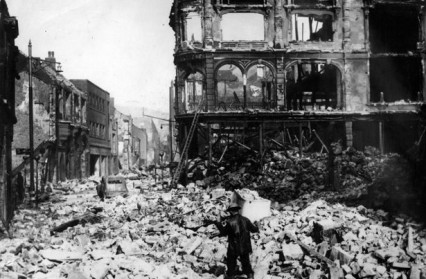Elin Williams casts a critical eye over Manon Eames’ new play Swansea’s Three Night Blitz at the Swansea Grand Theatre.
75 years ago the heart of Swansea was devastated by a three day bombing attack by the Luftwaffe. 230 Swansea locals lost their lives whilst over 400 people were injured. Iconic buildings were destroyed and the face of Swansea was changed forever.
Manon Eames’ new play Swansea’s Three Night Blitz tells the story of the people of Swansea who were affected by this terrifying attack in February 1941. Elsie Jenkins has been planning her wedding. She works in Swansea’s answer to Harrods, the Ben Evans Department store. Elsie and her fiancé Tommy are desperate to get married but their plans are disrupted by the chaos of war and the first raid on the city on the night of the 19th of February.

The performance is narrative driven, figures weaving in and out onto the stage as the characters of old Swansea. There is a great deal of humour and the local dialect is used to great effect, giving an authentic flavour; but ultimately, when the bombs begin to fall, this nostalgia ebbs away. It isn’t difficult to detect shades of Dylan Thomas’ Under Milk Wood as the audience is taken through different areas of Swansea, from St. Thomas to West Cross, following the lives of individuals soldiering on with their daily routines in wartime Britain. As the narrative shifts into sinister, tragic territory this light-hearted tone rapidly disintegrates.
The characters must flee desperately for shelter and the ARP wardens shepherd stricken citizens to safety. Snippets of dialogue convey the panic and tragedy effectively, but there are times when the fragmented monologues become jarring; talking to an audience in the midst of chaos doesn’t seem natural. One can’t help but feel that this technique of recounting horrific events to the audience lacks the sense of urgency it desperately needs.
The set is simple and effective. Paper aeroplanes cascade from the ceiling, whilst the use of a screen with projected images of bombed Swansea livens up the bare stage. The style of the piece means that a detailed set would not have been practical, but perhaps some symbolic items could have been added to offer some consistency to the scenes. As an ensemble cast, the actors flow seamlessly from one character to another, specifically Gwydion Rhys and Michelle McTernan. There are many characters to keep track of, but Elsie Jenkins remains the closest thing to a protagonist as we follow her and her loved ones through the three night ordeal. There is use of a contemporary character who bookends the performance, contrasting wartime Swansea to the modern day city, as she stands looking at Castle Gardens commenting on the difference 75 years can make.
Swansea’s Three Night Blitz is enjoyable and well-intentioned, but it is by no means revolutionary. Although there is some good writing to be enjoyed, ultimately the fragmented monologues and pieces of dialogue aren’t sufficient to communicate the unimaginable horror of a town almost completely flattened in three days of bloody bombing.
To find out about upcoming productions and events at the Swansea Grand Theatre visit their website.
Elin Williams is a writer and contributor to Wales Arts Review.
Swansea’s Three Night Blitz












